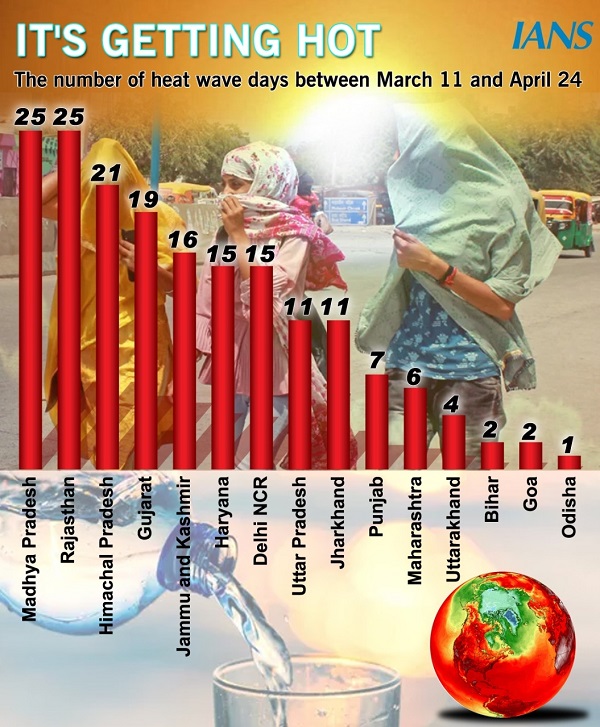New Delhi, (Samajweekly) The early heat waves of 2022, that began on March 11, have impacted 15 Indian states and Union Territories, as of Sunday, with Rajasthan and Madhya Pradesh suffering the most with 25 heat waves and severe heat wave days each during this period and also has had an adverse impact on the rabi crop.
According to an analysis of India Meteorological Data (IMD) data by the Centre for Science & Environment (CSE) Down to Earth (DTE) on Monday, after Rajasthan and Madhya Pradesh, the hill state of Himachal Pradesh has been the most affected by heat waves this year with 21 heat wave and severe heat wave days.
Although CSE/DTE counted the heat wave period as single phase from March 11 to April 24, the IMD had held that the first spell was from March 11 to 21 and the second spell started on March 26 and ended between April 20-23 for large parts of India with isolated pockets still witnessing heat wave and severe heat wave conditions.
As per IMD definition, a heat wave is when the temperature of any place crosses 40 degrees Celsius in the plains, 37 degrees in coastal areas, and 30 degrees in the hills. It also declares a heat wave when a place registers maximum temperature that is 4.5 to 6.4 degrees Celsius more than the normal temperature for the area for that day; and it is a severe heat wave if this temperature is over 6.4 degrees.
Another criterion used by the IMD to declare a heat wave is when temperature of a given place touches/crosses the 45 degrees Celsius mark and after 47 degrees Celsius, it is a severe heat wave.
“Anti-cyclones over western parts of Rajasthan in March and the absence of rain-bearing Western Disturbances had triggered the early and extreme heat waves. Anti-cyclones cause hot and dry weather by sinking winds around high pressure systems in the atmosphere,” said D. Sivananda Pai of the Kottayam-based Institute for Climate Change Studies.
Another climate scientist, Raghu Murtugudde from the University of Maryland, said: “A north-south pressure pattern, associated with the La Nina phenomenon in eastern and central Pacific Ocean that happens during winters in India, has persisted longer than expected and interacted with warm waves coming in from a rapidly warming Arctic region, leading to the heat waves.”
The sea surface temperatures over east and central Pacific Ocean become cooler-than-average during La Nina. This affects the trade winds flowing over the ocean surface through changes in wind stress. The trade winds carry this weather disturbance elsewhere and affect large parts of the world.
“In India, the phenomenon is mostly associated with wet and cold winters. Therefore, the current impact of La Nina on the spring and summer season in India is completely unexpected,” Murtugudde said, adding: “The heat waves may continue till at least the monsoon season begins in June.”
The part I of the IPCC’s (Intergovernmental Panel on Climate Change) Sixth Assessment Report in October 2021 had warned that every additional 0.5 degrees Celsius of warming will increase hot weather extremes, along with extreme precipitation and drought. Heat waves in India are likely to “last 25 times longer by 2036-2065” if carbon emissions remain high and push global temperature rise to 4 degrees Celsius by the end of the century.
Heat waves exert enormous impacts on health, agriculture and availability of water – all often related to each other in complex ways, the CSE/DTE analysis pointed out and said: “On the other hand, agricultural yields get impacted as well. For instance, the wheat crop in the current rabi season in Punjab, Haryana and Uttar Pradesh has been impacted by heat waves. Many farmers have reported losses between 20 and 60 per cent in these states.”
“This happened because the heat waves were early this year and the temperatures affected the wheat plants during their growth stage, leading to shriveled grains which fetch lower prices in the market, resulting in losses. To reduce agricultural losses due to heat waves, heat-tolerant varieties of wheat need to be developed,” it said.









